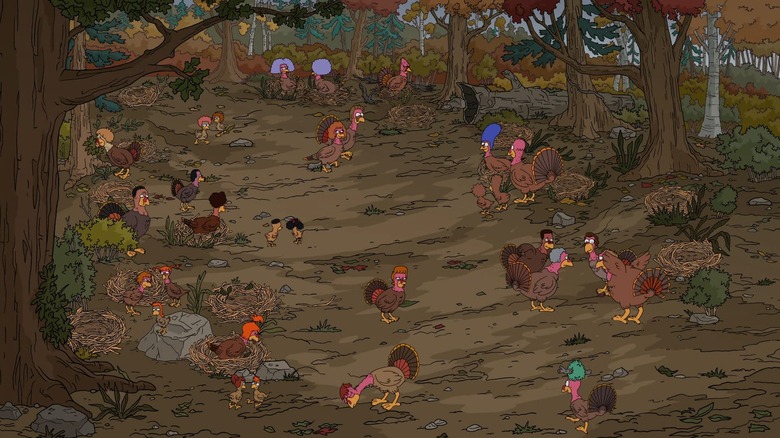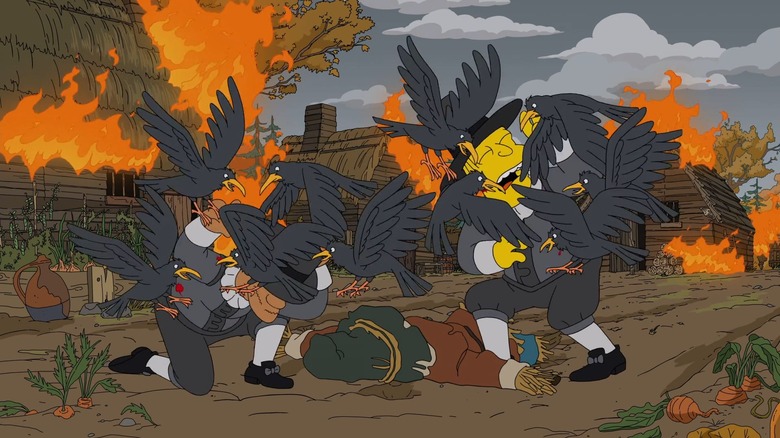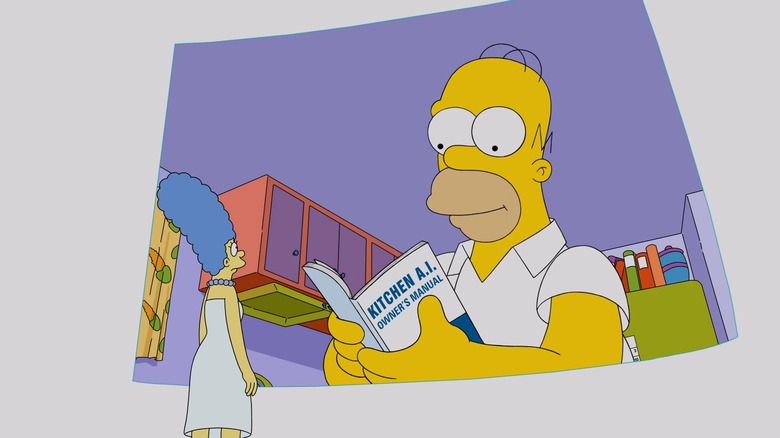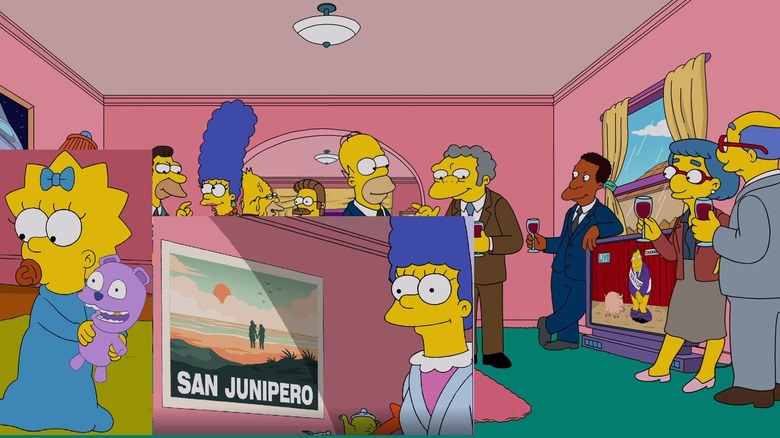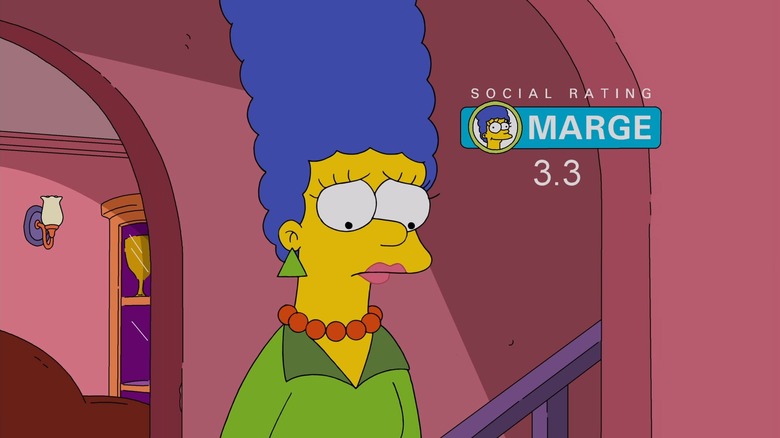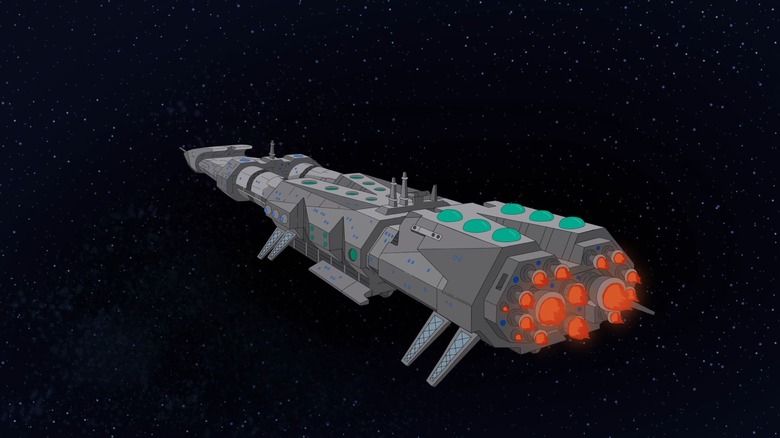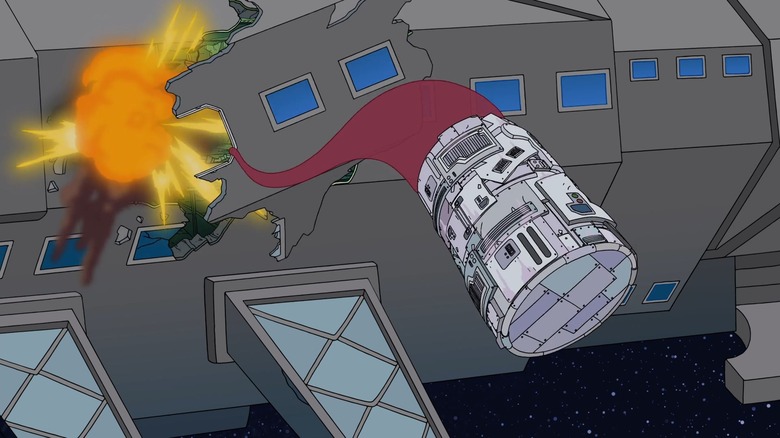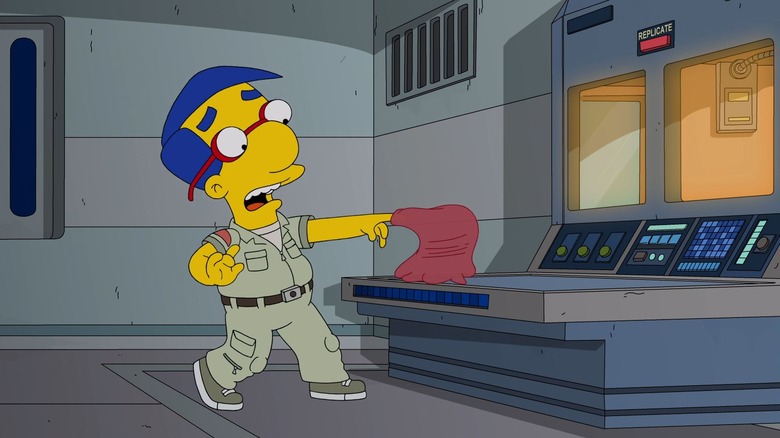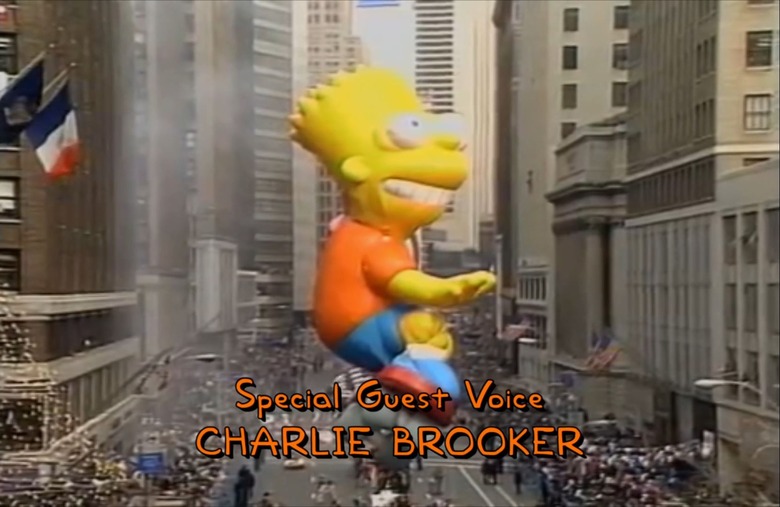Thanksgiving Of Horror: Breaking Down The Many Movie References In The Latest Episode Of 'The Simpsons'
Even after three decades, The Simpsons is still finding ways to keep things fresh. The latest example takes the long-running "Treehouse of Horror" and repeats it just a month after this year's proper "Treehouse" episode, but with a Thanksgiving setting.
The episode begins with Marge introducing three spooky tales of horror and warning the audiences not to let their kids watch – just like in the good old days. The thing is, as gimmicky as the episode seems to be, it is also one of the best horror episodes the show has done in years. "Thanksgiving of Horror" is also full of references to movies and TV shows, so we asked to the episode's writer, Dan Vebber, to guide us through all the easter eggs and reference in this scary holiday episode.
A Very Thanksgiving Apocalypto
The episode begins with a segment that's a very clear parody of Mel Gibson's Apocalypto, the movie about a man who is captured by Mayan conquerors and taken to a big city to be sacrificed to the gods. This being The Simpsons, instead of Mayans, the characters are now turkeys living in 1621, and Homer and a few others are captured by pilgrim hunters Constable Wiggum, Lou and Eddie.
It was this segment that sparked the idea for the episode. "Mat Selman, our executive producer wanted to do three Thanksgiving stories that would be scary," Dan Vebber told /Film over the phone. "And it was his idea to take the movie Apocalypto and do it with turkeys."
Of course, when Vebber says it's Apocalypto with turkeys, the episode goes all the way. Not only are the Simpsons and most of your favorite Springfield residents turkeys, but they all speak through gobbles. "That was an early decision," Vebber told us. "We thought it would ultimately seem a little bit funnier if it we just had them gobble without subtitles. Only a show as old as this one can fall back on the fact that we know these characters so well that just by giving them a particular emotion, we know more or less what they're saying. When Flanders Turkey walks up to Homer and says gobble, gobble, gobble, you know Ned well enough to know that what he's saying is 'Howdy-do neighborino!'"
The rest of the segment plays out pretty much exactly like Apocalypto, with Homer escaping and being chased by his captors, here in the form of Constable Wiggum. Then Homer witnesses his fellow Turkeys being sacrificed in probably the bloodiest scene in the show's history. "We wanted it to feel like if you're a turkey, Thanksgiving is pretty much a horror movie where you're being hunted down and slaughtered." Vebber said.
Scarecrows Actually Work
As Homer escapes the slaughter, Lou and Eddie start chasing after Homer, until they knock over a scarecrow. "Get it up, get it up! Shouts Lou, but then a murder of crows descends upon them and kills them, in a reference to Hitchcock's The Birds.
"That started as a joke about what if a scarecrow worked instantly," Dan Vebber explained. "Like the moment you took it down, real birds come down and kill you. And then when it was animated, we certainly talked about how the attack should look like the movie The Birds."
A Very ‘Black Mirror’ Thanksgiving
The first segment was about the first Thanksgiving, so the second is about a current Thanksgiving. In what is a direct parody of Black Mirror, it follows Homer as he buys a kitchen A.I. device to help Marge with making Thanksgiving dinner. The only thing is that the device has an A.I version of Marge with all her memories living inside an Amazon Alexa-like tube.
As Dan Vebber explains it, the segment is mostly a riff on the "White Christmas" episode of Black Mirror, which was the first TV special of the series and the last to air on TV before Netflix acquired the show. The episode deals with two men in a remote cabin on Christmas Day telling each other the story of their lives to pass the time. Jon Hamm stars as one of the men, and his story is about how he works training digital clones of people stored in egg-shaped objects that serve as personal assistants – and how one of those clones refused to be a personal assistant.
In The Simpsons version of the tale, Marge starts to slowly win over the family and replace the real Marge because she cooks just as well but isn't punishing or nagging her kids. Just like in "White Christmas," Homer fast-forwards the time inside the tube, which leaves Marge alone for years with no one to talk to while only a few seconds transpire in the real world.
"The idea of the episode was to make the audience root for the fake version of Marge instead of the real one," Vebber said. "We also filled the segment with as many easter eggs to Black Mirror as we could, like a clock on the kitchen wall being the same clock in 'White Christmas' and a snow globe that is also from that episode."
Many, Many, ‘Black Mirror’ Easter eggs
As Vebber explained, he just tried to include as many references as he could into the segment. These include a TV playing a live report where Mayor Quimby is standing next to a pig with his pants down, which is a reference to the very first episode of Black Mirror, "National Anthem," where the prime minister is blackmailed into having sex with a pig on national TV.
Likewise, there is a "San Junipero" poster on the dining room wall, which is a nod to the Black Mirror episode of the same about a beach resort town that's also a simulated reality for the elderly where they can relieve any decade they want, or even inhabit after they die. We even see Maggie playing with a Waldo stuffed doll from "The Waldo Moment", the episode about a satirical late-night comedy show with a blue CGI bear mascot that becomes a political contender.
Nosediving
The segment ends with fake Marge escaping to the Internet, and confessing that she was the one to make the Thanksgiving dinner, not real Marge. Instantly, all the dinner guests and friends of the Simpsons pull out their phones and we see a shot of Marge and a graphic for her "social rating" quickly go down, as a narrator says "social rating nosediving."
This is a nod to the Black Mirror episode "Nosedive" which starred Bryce Dallas Howard and deals with a world where everyone shares everything they do on social media, and every action can be given a rating, which affects one's socioeconomic status. This bit also had a surprise guest appearance "We actually had Charlie Brooker record the social rating dialogue," said Vebber, referring to Black Mirror creator, Charlie Brooker. "I came up with the idea of having him voice a computer at the end to say 'Firewall activated' but Matt Selman lobbied for 'social rating: falling.' We disagreed on this until the day we recorded the voices, which was when I came up with the 'nosediving' reference from the show. It was the perfect compromise between what we both wanted."
Thanksgiving: The Last Frontier
The last segment gives us the last (or first?) Thanksgiving, in a future where Earth has become uninhabitable and a colonization vessel is already a thousand light years away from the planet. The segment references a number of sci-fi films and TV shows, with a couple of nods devoted to Star Trek.
First, the segment begins with an opening narration by Lisa, who says "Ship's log. Interplanetary colonization vessel: humanity's hope," in reference to the many "Captain's log" from the sci-fi TV show. Later on, the children from The Simpsons wake up from hypersleep and decide to make Thanksgiving dinner by putting a can of cranberry juice in a "matter replicator" which is a device from Star Trek that can create and recycle things.
As the episode goes on, the replicated cranberry juice comes to life and becomes a monster obsessed with sucking bones out of the children's bodies. "That was based on a Star Trek episode where a creature would suck the salt out of a person," Vebber told us, referencing the episode "The Man Trap" from the first season of the show. "So we thought of other things that the creature could suck out, and I thought that it would be funny to see somebody's skeleton get pulled out of them before they were left with this floppy skin sack. It also had the advantage of allowing us to say that because it's a gelatin-based creature and gelatin is made out of bones, it all sort of made sense.
Cranberry: The Eighth Passenger
The bulk of the episode deals with the kids trying to escape and kill the cranberry monster before it sucks out their bones and kills them. Of course, the alien-set-loose-on-a-spaceship plotline is straight out of Alien, and indeed the segment ends with Bart and Lisa putting the monster on the airlock and throwing it out into space – which is how the original Alien ended.
This segment is also the last time we'll hear Russi Taylor as the voice of Martin Prince. In the segment, Martin acts as Ash, the android from the original Alien who sacrifices the crew of the Nostromo in order to capture the xenomorph to study it. In the episode, Martin decides that the cranberry monster is the ultimate life form, and helps it kill his classmates before getting killed by the blob himself. "I recorded Russi for that role," Vebber said. "She was so into it she was really just laughing her head off. She thought it was so funny that at the end Martin's entire skeleton just gets sucked out of him, and she really got into it, asking what the noises would be as he's getting his skeleton sucked out. She was having the best time."
Getting a Life
While Alien is the more obvious reference, Vebber confesses that he was inspired by a different and more recent sci-fi horror film. "At the time my first draft was finished, I realized that it was much more influenced by the more recent movie called Life," Vebber told us. "Of course the idea was to do a monster-on-a-spaceship-type story like Alien, but I was more inspired by how Life begins with this kind of blob that is kind of cute." Indeed, the movie begins with the discovery of an alien creature which looks like a blob and becomes the movie's equivalent of Baby Yoda, with the entire world becoming obsessed with it, with a group of school children naming the alien "Calvin." "So then we have Milhouse be the one to get too close to it and lose his arm as the blob sucks the bones out of his arm. As the blob starts eating people, it becomes larger and larger."
The Balloon That Dripped Blood
The very last reference isn't technically part of a segment, but of the closing credits. After the last segment ends, the closing credits play over footage of the 1991 Macy's Thanksgiving Day Parade, where a giant balloon of Bart Simpson paraded down the streets of New York City. The footage is accompanied by very creepy music that somehow perfectly fits the visuals of a giant Bart floating above the street. "The score is from a movie called The House That Dripped Blood," Dan Vebber explained. "It ends on that very sinister notion that has a lot to say on American consumerism."

